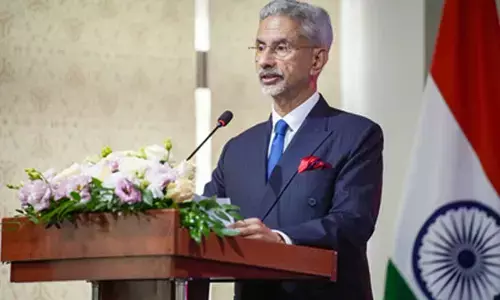Internationalisation of Rupee can be remedy for growth and stability

The Report of the Inter-departmental Group (IDG) on internationalisation of INR that was released by the RBI comes up with some interesting suggestions as policy-makers strive to achieve goal.
Currently the US dollar is the dominant global currency, and serves as a unit of account, medium of exchange and store of value.
Even though attempts were made to promote alternative currencies they failed because of US size of economy, its strong reach of global trade and liquidity and currency convertibility.
However too much dependence on one currency has its own implications for other countries in times of adverse economic, financial, geo-political situation (the Russia-Ukraine war) and volatility in growth and monetary actions.
Attempts to bring an alternative currency system as compared to the US Dollar and Euro did not succeed although the extent of the US dollar as a part of foreign exchange reserves has come down to 58.9 per cent in the first quarter of 2022 against 85 per cent in 1970 , 70 per cent in the early 2000. The share of its GDP as a percentage of the world GDP has declined from 40 per cent to 24 per cent over the same period. Among other currencies, China has yet to catch up in terms of fully convertible in capital account, development of financial markets and transparency.
It is therefore felt necessary for India to think in terms of Internationalisation of INR. Rupee becoming an international currency depends upon the size of its economy, economic stability, financial and macro-economic strengths, a consistent monetary policy, the stability and extent of the rupee, among several other parameters.
Meanwhile, after Covid-19, Indian economy has revived in faster mode and the macroeconomic situation is in a favourable position having become fifth largest economy.
The rupee has also been able to withstand the recent turmoil in global markets. Our foreign exchange reserves have come in handy while managing the large outflow and uncertainties in inflow and recouping of reserves. Our current fiscal and financial strength should enable us to take up short, medium and long term steps and go towards enabling our INR as an alternative international currency of value.
RBI has taken first step by permitting exporters and importers to trade invoicing in INR and also allowing banks to permit rupee accounts of foreign banks. This has resulted in few positive steps towards internationalisation of INR.
Our recent efforts to diversify the supply of oil, and average the cost of oil imports has met with great success by Russian oil imports wherein the payment mechanism in INR has helped to some extent. The surplus of INR arising out of import payment should be adjusted towards our exports. Invoicing and settling of international trade transactions in INR with partners with whom we have a trade deficit will generally lead to a reduction in the current account deficit denominated in convertible currencies.
According to the report, there will be a reduced need to maintain large foreign exchange reserves in convertible currencies. It may be mentioned that maintaining large foreign exchange reserves has an implied cost aspect also even though we are forced to have certain months of imports maintained in foreign exchange reserves.
0ther timely measures taken by RBI include: 1. Allowing issuance of offshore rupee-denominated ‘masala ‘ bonds; 2. Allowing domestic banks to freely offer foreign exchange prices to NRIs at all times and 3. Allowing rupee derivatives (with settlement in foreign currency) to be traded in international finance centres (IFSCs).
Part A of the report discusses the approach towards the objective of internationalisation of INR. Part B discusses the various initiatives taken up by India towards this end. The areas suggested are full capital account convertibility in order to broaden investor base for the country’s financial assets, improve liquidity in the domestic financial markets, induce positive pressures for market infrastructure and market practices, enable access to global savings thereby reducing borrowing costs and facilitate better risk allocation and enhance global liquidity.
The IDG opines that capital account convertibility is not a pre-condition for internationalisation of INR and vice-versa (as seen in the case of Renminbi). The Second IDG feels that the availability of INR liquidity both at the level of government and central banks levels and also at the level of commercial banks to provide the requisite confidence to all stakeholders, economic agents and market participants for settling cross-border transactions in INR. The suggested steps include local currency settlement and swaps. The availability of cross- border infrastructure is the third area to be focused, providing timely interbank transfers and settlement.
Our dependence on SWIFT should be reduced by enabling RTGS, NEFT and UPI for cross-border transactions. Introduction of ‘Central Bank Digital Currency’ can also lead to cross-border payments in future.
The IDG also recommends inclusion of INR in Continuous Linked Settlement (CLS). Other areas discussed were in further deepening financial markets as the growth and size of the offshore market has implications for price discovery of INR exchange rate vis-à-vis other domestic currencies of trading partners. IDG has also suggested approach for long term scope of INR as ‘vehicle currency”. With greater CAC, deep and liquid financial markets and strong macroeconomic indicators, it is expected that INR would be used by other economies for pegging their currencies, which will fulfil the requirement of INR being used as ‘vehicle currency’ by other jurisdictions in their Forex intervention to maintain the value of their currency.
Even though the recommendations of IDG cannot be treated as the official position of RB1, the report and its recommendations are of importance and both the government and RBI will continue to focus on internationalisation of INR. The present global events are ideal for the country to move towards internationalism of INR and provide stability to such countries, which look up to India.




















